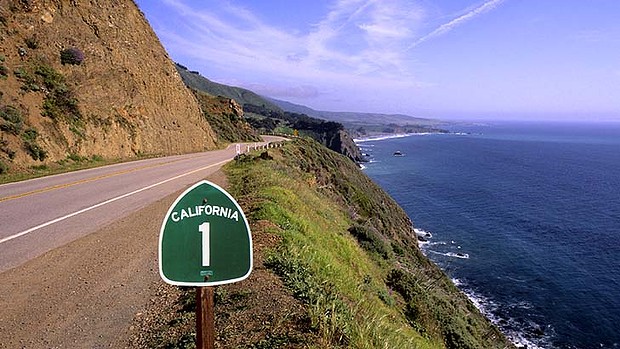California out in front in a Green future: Difference between revisions
Siterunner (talk | contribs) No edit summary |
Siterunner (talk | contribs) No edit summary |
||
| Line 15: | Line 15: | ||
At the time, all those nice-sounding goals were just words in a speech. But they could very soon become the law of the land. The state legislature is currently considering several bills (SB 350 is the most important) that would codify Brown's climate agenda. The legislation is widely expected to pass before the end of the legislative session next Friday, but not without a fight from the state's powerful oil lobby... | At the time, all those nice-sounding goals were just words in a speech. But they could very soon become the law of the land. The state legislature is currently considering several bills (SB 350 is the most important) that would codify Brown's climate agenda. The legislation is widely expected to pass before the end of the legislative session next Friday, but not without a fight from the state's powerful oil lobby... | ||
○ ○ ○ ○ | |||
''California has a history that derives from the experience of smog in the Los Angeles Basin... standards that were established under the so-called [http://www.npr.org/templates/story/story.php?storyId=5744849 '''Pavley Law'''], '''the first legislation in the world to regulate greenhouse gas emissions in passenger vehicles''', were ultimately adopted by the United States as the national standard. [http://www.arb.ca.gov/cc/ccms/ccms.htm] [http://www.arb.ca.gov/cc/cc.htm#Background] [https://en.wikipedia.org/wiki/Climate_change_in_California]'' | |||
○ ○ ○ ○ ○ ○ ○ ○ ○ ○ ○ ○ ○ ○ ○ ○ ○ ○ ○ ○ ○ ○ ○ ○ ○ ○ ○ ○ ○ ○ ○ ○ ○ ○ ○ ○ ○ ○ ○ ○ ○ ○ ○ ○ ○ ○ ○ ○ ○ ○ | ○ ○ ○ ○ ○ ○ ○ ○ ○ ○ ○ ○ ○ ○ ○ ○ ○ ○ ○ ○ ○ ○ ○ ○ ○ ○ ○ ○ ○ ○ ○ ○ ○ ○ ○ ○ ○ ○ ○ ○ ○ ○ ○ ○ ○ ○ ○ ○ ○ ○ | ||
Revision as of 19:33, 4 September 2015
From the Bioneers, Kenny Ausubel
http://bit.ly/howcanwegrowtheworldwewant
○ ○ ○ ○ ○ ○ ○ ○ ○ ○ ○ ○ ○ ○ ○ ○ ○ ○ ○ ○ ○ ○ ○ ○ ○ ○ ○ ○ ○ ○ ○ ○ ○ ○ ○ ○ ○ ○ ○ ○ ○ ○ ○ ○ ○ ○ ○ ○ ○ ○
Update: California is about to do something no state has done - Sept 2015
Back in January, California Gov. Jerry Brown (D) made a promise. His state, he said, would pursue a new package of climate goals that are the most ambitious in the nation (and among the most ambitious in the world). California was already a leader in efforts to slash greenhouse gas emissions and promote clean energy. Brown pledged to go further. By 2030, he declared, California would double the energy efficiency of state buildings; get half its electricity from renewables; and halve consumption of gasoline by cars and trucks.
At the time, all those nice-sounding goals were just words in a speech. But they could very soon become the law of the land. The state legislature is currently considering several bills (SB 350 is the most important) that would codify Brown's climate agenda. The legislation is widely expected to pass before the end of the legislative session next Friday, but not without a fight from the state's powerful oil lobby...
○ ○ ○ ○
California has a history that derives from the experience of smog in the Los Angeles Basin... standards that were established under the so-called Pavley Law, the first legislation in the world to regulate greenhouse gas emissions in passenger vehicles, were ultimately adopted by the United States as the national standard. [1] [2] [3]
○ ○ ○ ○ ○ ○ ○ ○ ○ ○ ○ ○ ○ ○ ○ ○ ○ ○ ○ ○ ○ ○ ○ ○ ○ ○ ○ ○ ○ ○ ○ ○ ○ ○ ○ ○ ○ ○ ○ ○ ○ ○ ○ ○ ○ ○ ○ ○ ○ ○
What happens when enlightened policies are put in place?
In the absence of sufficient U.S. federal leadership, it’s cities and states that are largely moving the needle on addressing climate disruption. As the world’s 8th largest economy California has long played a catalytic role in the development of landmark national environmental laws and standards. California continues to serve as a model. [4]
As Tom Hayden has reported, “Since Governor Jerry Brown’s first term in 1974, California has been on a steady march to an alternative energy future. Enter Brown today as a modern Archimedes, the ancient Greek philosopher who searched for a leverage point from which to transform the world. California is that leverage point.”
Governor Brown began his current term by passing game-changing climate legislation, and building on the AB32 global warming legislation of the previous Governor. He has populated the administration with savvy, skillful policy makers designing leading-edge climate policies. Coupled with visionary lawmakers, the state has developed and implemented a broad suite of clean energy and low-carbon incentives and policies, while maintaining a fairly robust economy and green jobs creation.
California is poised to spend $120 billion on clean energy in the next five years, more than any other state and most foreign countries. Its plan is to achieve 33 percent of its electricity from renewables by 2020, and may double its rate by 2030. Consumers have saved an estimated $74 billion on energy efficiency programs. Silicon Valley leads the U.S. with 2/3 of green venture capital.
While fracking policy remains a serious unresolved issue, California is showing how an advanced economy can set future targets of 100 percent renewables without nuclear power. Goals in the coming decade include 1.5 million zero-emission cars and a million solar rooftops. New state building codes are driving the proliferation of zero-net energy buildings.
Meanwhile distributed energy is on its way to democratizing clean energy and displacing centralized fossil-fueled utility monopolies.
Dispelling the “jobs versus the environment myth,” California employs 199,000 workers in clean energy industries, with 100s of thousands more planned. Clean economy jobs jumped 20% over the past decade while other jobs rose only 2%. [In California in 2013, 7,755 projects were announced. 1,880 projects were under construction, 15,397 total projects were in operation.] There are already more clean energy jobs in the U.S. than jobs in the coal, oil and gas industries.
Major environmental justice legislation is set to assure hundreds of millions of dollars to implement climate policies and jobs that benefit frontline communities. That environmental justice vision will be key to international negotiations. Environmental justice has been the deal-breaker between the rich and poor countries — the poor did not create the problems yet suffer the brunt.
Governor Brown’s strategic end-run using clean energy diplomacy has led to low-carbon pacts with China, Germany, Mexico, Israel, Peru, Quebec, British Columbia, and multiple states in the Pacific Northwest, the Midwest and New England. As a Model for Regional-Local Approaches to Climate Change, the Pacific Coast Action Plan on Climate & Energy stands out.
Governor Brown has helped assemble a Green Bloc of states including the Northeast and Midwest that include at least half the American population and over 40 percent of the economy, with total GDP of $6.4 trillion. Former Governor Schwartzenegger and former New York City Mayor Michael Blooomberg are also building local and regional alliances. Many other nations are rooting for the Green Bloc’s continuing political rise.
The strategy is to force action federally and internationally from below. As Governor Brown commented, “What happens in California doesn’t stay in California.” [5] [6]
Changing the politics will come down to growing the national and global movement of movements.
_____________________________________________________
It’s here; it’s big; it’s real; it matters.
There is today a climate movement - Todd Gitlin
_______________________________________
September 23rd -- UN Climate Summit
____________________________________
Celebrating the Bioneers 25th Anniversary Conference

